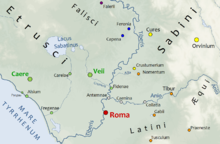20:
116:), etc., whence we may infer that it continued to be a tolerably flourishing town as late as the 4th century. In these inscriptions it is uniformly termed Cures Sabini, an epithet probably indicating the claim set up by the people to be the metropolis of the Sabines. It appears as the seat of a bishop in the 5th century, after the establishment of Christianity. The bishops assumed the title of
175:
209:
373:
383:
139:, the eastern by the citadel, and the lower ground between the two by the city itself. Excavations from 1874 up until 1877 revealed a temple, forum, baths, etc.
112:
notices the
Curenses as one of the municipal towns of the Sabines; and numerous inscriptions of Imperial date speak of its magistrates, its municipal senate (
199:
108:. At the beginning of the imperial period, it is spoken of as an unimportant place, but seems to have risen to greater prosperity in the 2nd century.
223:
378:
324:
135:
The site consists of a hill with two summits, round the base of which runs the Fosso Corese: the western summit was occupied by the
190:
368:
218:
275:
186:
160:
104:
Its importance among the
Sabines at an early period is indicated by the fact that its territory is often called simply
164:
82:. Another legend, related by Dionysius, connects the foundation of Cures with the worship of the Sabine god
363:
32:
19:
288:
109:
129:
94:
357:
213:
194:
181:
75:
148:
90:
67:
47:
63:
59:
136:
339:
326:
101:, Numa Pompilius resided in Cures immediately prior to his election as king.
74:
the Sabine settlers, from whom, after their union with the settlers on the
125:
79:
71:
212: This article incorporates text from a publication now in the
203:. Vol. 7 (11th ed.). Cambridge University Press. p. 637.
28:
292:
43:
24:
180:
This article incorporates text from a publication now in the
55:
18:
270:
98:
51:
245:
243:
241:
62:. Its remains are located in the modern commune of
50:in central Italy, about 26 miles (42 km) from
374:Populated places disestablished in the 6th century
132:states that in 593 the site was already desolate.
124:. The town seems to have been destroyed by the
66:. According to legend, it was from Cures that
8:
89:It was also renowned as the birthplace of
384:Former Roman Catholic dioceses in Italy
237:
224:Dictionary of Greek and Roman Geography
78:, the whole Roman people took the name
35:. Cures appears at upper right center.
249:
7:
166:Papers of the British School at Rome
23:Rome and its Environs, showing the
14:
207:
173:
54:, between the left bank of the
1:
379:Archaeological sites in Lazio
120:, and sometimes even that of
221:, ed. (1854–1857). "Cures".
169:, iii. 34–35, 1906. (T. As.)
400:
128:in 589 AD. An epistle of
316:, vol. i. pp. 532, 533.
303:, vol. i. pp. 532, 533.
200:Encyclopædia Britannica
227:. London: John Murray.
36:
369:589 disestablishments
22:
16:Ancient town in Italy
122:Episcopus Sabinensis
340:42.1825°N 12.6866°E
336: /
86:, whence Quirites.
291:. iii. 12. s. 17;
37:
391:
351:
350:
348:
347:
346:
345:42.1825; 12.6866
341:
337:
334:
333:
332:
329:
317:
310:
304:
286:
280:
268:
262:
259:
253:
247:
228:
211:
210:
204:
179:
177:
176:
118:Curium Sabinorum
97:. According to
399:
398:
394:
393:
392:
390:
389:
388:
354:
353:
344:
342:
338:
335:
330:
327:
325:
323:
322:
320:
311:
307:
287:
283:
276:Ab urbe condita
269:
265:
260:
256:
248:
239:
235:
217:
208:
185:
174:
172:
157:
145:
42:was an ancient
17:
12:
11:
5:
397:
395:
387:
386:
381:
376:
371:
366:
356:
355:
319:
318:
305:
281:
263:
254:
236:
234:
231:
230:
229:
219:Smith, William
205:
195:Chisholm, Hugh
170:
156:
153:
152:
151:
144:
141:
130:Pope Gregory I
95:Numa Pompilius
91:Ancient Rome's
15:
13:
10:
9:
6:
4:
3:
2:
396:
385:
382:
380:
377:
375:
372:
370:
367:
365:
364:Sabine cities
362:
361:
359:
352:
349:
315:
309:
306:
302:
298:
294:
290:
285:
282:
278:
277:
272:
267:
264:
258:
255:
251:
246:
244:
242:
238:
232:
226:
225:
220:
215:
214:public domain
206:
202:
201:
196:
192:
188:
187:Ashby, Thomas
183:
182:public domain
171:
168:
167:
162:
159:
158:
154:
150:
147:
146:
142:
140:
138:
133:
131:
127:
123:
119:
115:
111:
107:
102:
100:
96:
92:
87:
85:
81:
77:
73:
69:
65:
61:
57:
53:
49:
45:
41:
34:
30:
26:
21:
321:
313:
308:
300:
299:107; Nibby,
296:
284:
274:
266:
257:
222:
198:
165:
161:Thomas Ashby
149:Tiber Valley
134:
121:
117:
113:
106:ager Sabinus
105:
103:
93:second king
88:
83:
68:Titus Tatius
48:Tiber Valley
46:town in the
39:
38:
343: /
70:led to the
64:Fara Sabina
60:Via Salaria
358:Categories
331:12°41′12″E
328:42°10′57″N
250:Ashby 1911
233:References
137:necropolis
189:(1911). "
33:Etruscans
314:Dintorni
301:Dintorni
143:See also
126:Lombards
84:Quirinus
80:Quirites
76:Palatine
72:Quirinal
58:and the
312:Nibby,
261:ii. 48.
216::
197:(ed.).
184::
155:Sources
29:Sabines
297:Inscr.
293:Orelli
279:, 1:18
193:". In
178:
44:Sabine
31:, and
25:Latins
191:Cures
110:Pliny
56:Tiber
40:Cures
289:Plin
271:Livy
114:ordo
99:Livy
52:Rome
163:in
360::
295:,
273:,
240:^
27:,
252:.
Text is available under the Creative Commons Attribution-ShareAlike License. Additional terms may apply.
